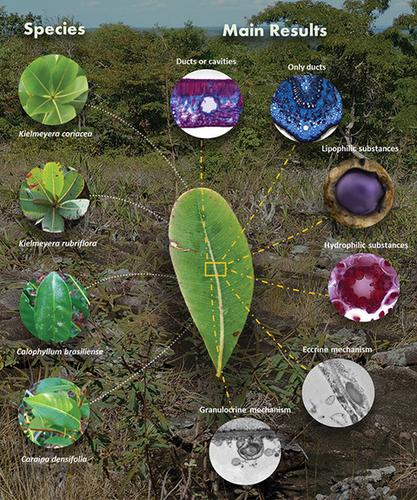当前位置:
X-MOL 学术
›
Plant Biol.
›
论文详情
Our official English website, www.x-mol.net, welcomes your feedback! (Note: you will need to create a separate account there.)
Structural and histochemical attributes of secretory ducts and cavities in leaves of four species of Calophyllaceae J. Agardh in Amazonian savannas
Plant Biology ( IF 3.9 ) Pub Date : 2021-09-06 , DOI: 10.1111/plb.13321 M. J. G. Pessoa 1, 2 , S. Pireda 2 , P. Simioni 1, 2 , N. Bautz 2 , M. Da Cunha 1, 2
中文翻译:

亚马逊稀树草原 4 种 Calophyllaceae J. Agardh 叶片中分泌管和腔的结构和组织化学特性
更新日期:2021-10-28
Plant Biology ( IF 3.9 ) Pub Date : 2021-09-06 , DOI: 10.1111/plb.13321 M. J. G. Pessoa 1, 2 , S. Pireda 2 , P. Simioni 1, 2 , N. Bautz 2 , M. Da Cunha 1, 2
Affiliation

|
- This study represents an important contribution to the structural, histochemical and biological understanding of ducts and cavities in leaves of four species of Calophyllaceae that occur in Amazonian savannas.
- Samples of adult leaves were processed using light, scanning and transmission electron microscopy, as per usual methods for plant anatomy.
- In paradermal sections, the lumina of ducts are elongated while those of cavities are short. Ducts occur exclusively in the central rib and are abundant in Kielmeyera rubriflora Cambess and Kielmeyera coriacea Mart. and Zucc and larger than in Calophyllum brasiliense Cambess and Caraipa densifolia Mart. In mesophyll, the type of secretory structure and distribution pattern of the ducts and cavities are distinct. In most species, the secreted metabolites are similar and consist of phenolic compounds, lipids, essential oils with oleoresins, mucilage, neutral polysaccharides, proteins and alkaloids, except in K. coriacea, which does not contain oleoresin. The secretion is probably synthesized by mitochondria, rough endoplasmic reticulum, ribosomes and dictyosomes and is externalized toward the lumen by granulocrine and eccrine processes.
- In addition to being of diagnostic value for species identification, the attributes of the lumen shape, type of secretory structure, distribution pattern, identified metabolites and secretion mechanism are important for understanding the biological roles of ducts and cavities. The identified metabolites reveal a capacity for adaptation, resistance and protection from the action of herbivores and pathogens, and in water retention.
中文翻译:

亚马逊稀树草原 4 种 Calophyllaceae J. Agardh 叶片中分泌管和腔的结构和组织化学特性
- 这项研究对亚马逊热带稀树草原中四种 Calophyllaceae 的叶片中导管和空腔的结构、组织化学和生物学理解做出了重要贡献。
- 按照植物解剖学的常用方法,使用光、扫描和透射电子显微镜处理成年叶样品。
- 在皮旁切片中,导管的管腔是细长的,而腔的管腔是短的。导管仅出现在中央肋骨中,并且在Kielmeyera rubriflora Cambess 和Kielmeyera coriacea Mart 中很丰富。和 Zucc 并且比Calophyllum brasiliense Cambess 和Caraipa densifolia Mart 大。在叶肉中,导管和腔的分泌结构类型和分布模式是不同的。在大多数物种中,分泌的代谢物是相似的,由酚类化合物、脂质、含油树脂的精油、粘液、中性多糖、蛋白质和生物碱组成,除了K. coriacea, 不含油树脂。分泌物可能由线粒体、粗面内质网、核糖体和双糖体合成,并通过颗粒分泌和外分泌过程外化到管腔。
- 除了对物种鉴定具有诊断价值外,管腔形状、分泌结构类型、分布模式、鉴定的代谢物和分泌机制的属性对于理解导管和腔的生物学作用也很重要。鉴定出的代谢物揭示了适应、抵抗和保护免受食草动物和病原体作用以及保水的能力。

































 京公网安备 11010802027423号
京公网安备 11010802027423号